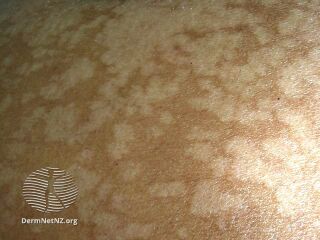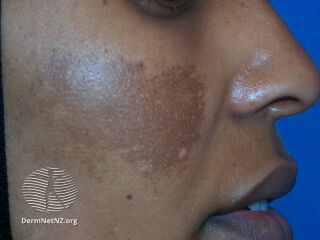Pigmentation disorder
| Pigmentation disorder | |
|---|---|
Pigmentation disorders are disturbances of human skin color, generally involving an abnormal pigmentation of skin, or underproduction or overproduction of melanin.[1] It may occur in a lace-like pattern.[1]
It includes conditions with abnormal pigmentation; hemosiderin hyperpigmentation, medication pigment, post inflammatory hyperpigmentation, and melasma.[1] Some form a lace-like pattern pigment; dyschromatosis symmetrica hereditaria, dyschromatosis universalis hereditaria, Dowling–Degos disease, Galli-Galli disease and reticulate acropigmentation of Kitamura.[1] Others include erythema dyschromicum perstans.[2] There may be a loss or reduction, which may be related to loss of melanocytes or the inability of melanocytes to produce melanin or transport melanosomes correctly.[1]
It is common among people with darker skin.[2]
References
- ↑ 1.0 1.1 1.2 1.3 1.4 James, William D.; Elston, Dirk; Treat, James R.; Rosenbach, Misha A.; Neuhaus, Isaac (2020). "36. Disturbances of pigmentation". Andrews' Diseases of the Skin: Clinical Dermatology (13th ed.). Edinburgh: Elsevier. pp. 862–880. ISBN 978-0-323-54753-6. Archived from the original on 2023-03-30. Retrieved 2023-05-05.
- ↑ 2.0 2.1 Onalaja, Amanda A.; Taylor, Susan C. (2021). "1. Defining skin color". In Li, Becky S.; Maibach, Howard I. (eds.). Ethnic Skin and Hair and Other Cultural Considerations. Switzerland: Springer. pp. 11–13. ISBN 978-3-030-64829-9. Archived from the original on 2022-09-27. Retrieved 2022-08-29.
External links
| Classification |
|---|

